The Telecaster was originally designed as a budget guitar that could bridge the gap between affordability and performance, but this iconic single-cut guitar remains one of the most iconic and popular body shapes around to this day.
The problem is that as the Telecaster’s popularity increased, Fender bumped it up into the ranks of their premium models, making it pretty expensive and largely inaccessible to anyone on a tighter budget.
Fender’s subsidiary company Squier does make some great affordable Telecaster-style instruments such as the Sonic Esquire Tele, and the newly launched Squier Debut Series Telecaster which costs less than $150 (hint: I've bought, tested and discussed it in this article).
But the real magic lies in the non-Fender Tele’s. Other companies have found cool and interesting ways to play with the T-guitar formula outside of the creative constraints that Fender are obliged to adhere to.
Particularly some of the low to mid-range Tele-style guitars from other brands offer incredible value for money that you simply won't find from the big F.
Top 3 - Non-Fender Telecasters
Preview | Product | Price |
|---|---|---|
 | ||
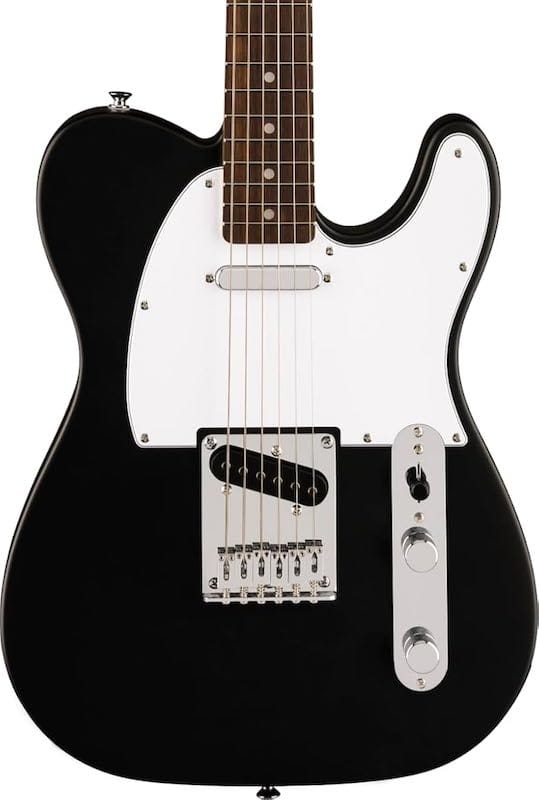 | ||
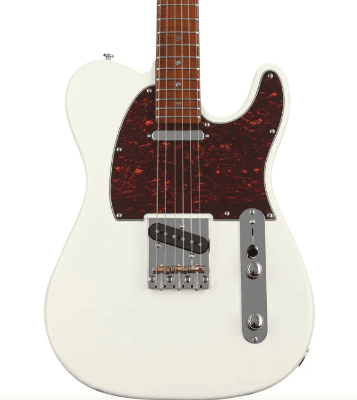 |
So after a lot of searching and testing, here are 7 of the very best non-Fender Telecaster style guitars that fit a range of budgets, each offering a unique twist on the traditional T-formula.
For the guitars that I've specifically gotten my hands on for this article, I plugged them into my Fender Blues Jr. amp for testing, to keep the non-guitar factors as constant as possible. For others, I didn't need to test them again specifically for this article since I already had quite a bit of experience owning or playing them earlier.
7 Best Non-Fender Telecaster Guitars - Affordable Tele Alternatives!
1. Schecter PT Special
You might be surprised to see a Schecter make this list as they are most often associated with making guitars geared for heavy metal music.
But don’t write them off just yet. When I first saw and acquired the PT Special, it impressed me with how authentically it nailed the feel of a Telecaster, while still introducing a few unique quirks that give it its own personality too.

Schecter PT Special
The PT stands for Peter Townshend who was the lead guitarist for legendary British rock band The Who.
The core philosophy of this guitar was to design a more muscular Telecaster that tonally produces much more hair, grit, and overtones thanks to the bright (and very light, be warned) swamp ash body which is paired with Schecter's own Diamond V-90 and VT-1 pickups.
The P-90 style neck pickup in particular impressed me with how thick and rich it sounds, it certainly contrasts the thin and twangy lipstick-style pickup you might find on a real Fender Tele.
This pickup combination allows you to cover anything from Tele classics like Amos Moses by Jerry Reed, Buckaroo by Buck Owens etc. to heavier modern day stuff with equal ease. Coupled with a modern modeling amp or an amp-in-a-pedal setup, this guitar can handle almost everything.
The neck feels more appropriate for the modern player thanks to its C profile and flatter 12” radius. It plays much more smoothly than a traditional 9.5” radius neck. So if you enjoy playing fast this is going to feel much nicer in the hands.
It comes in a number of colors/finishes, particularly the 3-tone Sunburst with maple fretboard looked exceptionally exquisite to me, prompting me to go for it.
2. Squier Debut Series Telecaster
I know, I know... "But Squier is Fender, and you promised non-Fender Teles in this article..."
Well, the situation (at least until a few months ago) used to be that, if you wanted a genuine, Fender-backed, Squier-made Telecaster (or Strat) for under $150, you didn't have a choice. You had to either increase your budget to around $199 for the Squier Sonic series, or inevitably get one of those cheap knockoffs for $100-120. But not anymore!
The debut series Telecaster by Squier is probably the single most affordable path to getting a real Telecaster and can work great as someone's first guitar or as a project instrument where you can implement some aftermarket upgrades.
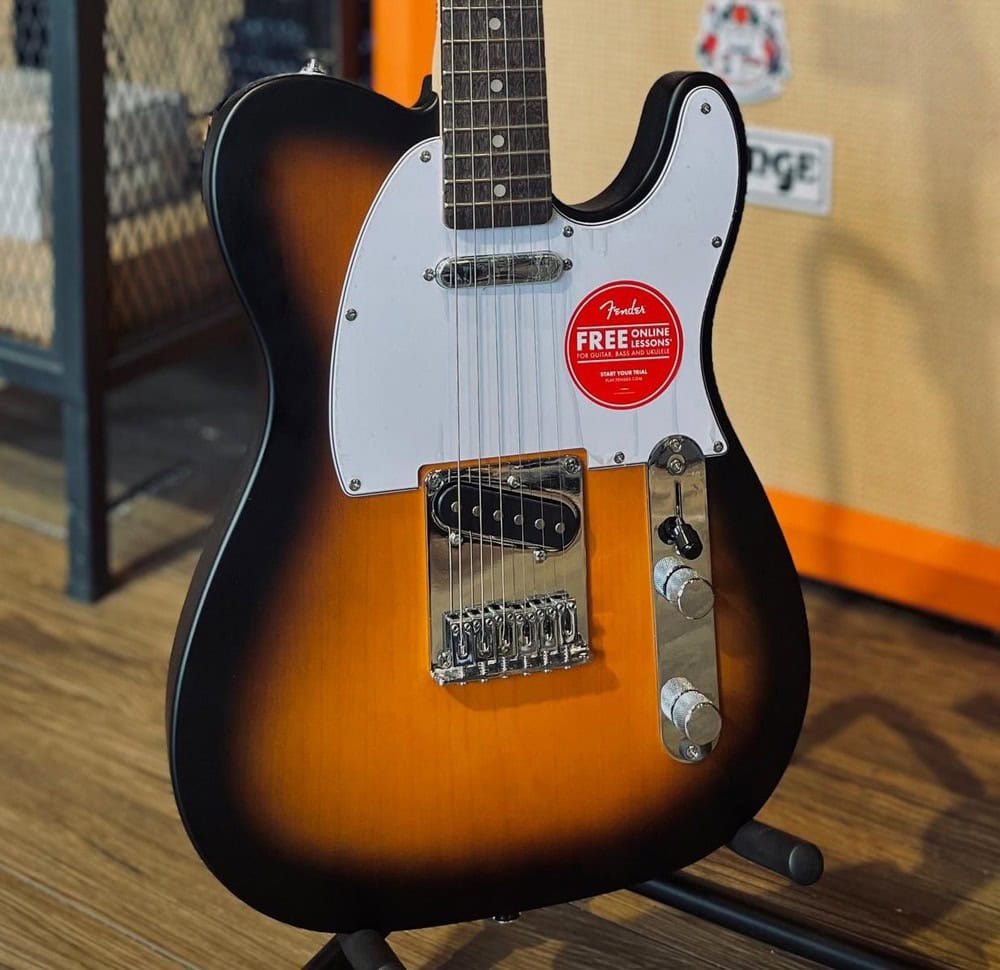
Squier Debut Series Telecaster in Sunburst
Out of the box, the guitar felt light and comfortable to hold. The body is slightly thinner than a Fender Tele, contributing to the weight savings, but it was not noticeable enough in a bad way. I liked the satin finish. I actually prefer it over the typical gloss finish owing to it being less susceptible to fingerprints (thus being easy to maintain).
The action was low enough for my preference. The (ceramic) pickups are decent, especially if you consider the price point. You won't find much difference between the ones on this one and the ones present on Squier Sonic guitars.
However, you'll be disappointed if you expect the same level of brightness or bite of the expensive Fender Telecasters. But if you're a beginner (i.e. the target audience of this Tele), it won't matter to you because you'll likely not have a Fender Tele lying around for comparison!
The frets sitting on top of the Laurel fingerboard were finished nicely (no rough edges or unevenness) and the Maple neck had the typical smooth, silky touch that budget Squiers do not typically miss out on.
Honestly, the first impressions you'll have once you get hold of this guitar is way, way better than what it would've been if you'd purchased a cheap Tele clone at a similar price point. It resembles a higher-tier guitar when it comes to the look and feel.
I've been playing guitar for more than two decades now, and I've had my fair share of trying out cheap Tele knockoffs. I'm super glad that Fender has finally managed to cater to this budget conscious, entry-level segment because this was needed!
I wasn't too impressed with the stock strings, though. I'm not sure if they were Fender 250's as you usually see on Squiers, but I switched to D'Addario NYXLs after around 10 days of ownership, and it greatly improved not just the tone, but the tuning retention too.
3. Sire Larry Carlton T7
Despite being a signature model guitar, the Larry Carlton T7 Signature Telecaster is a worthy consideration regardless of whether you’re a fan of Larry or not because it has such a neutral and understated look. This guitar is appropriate for anyone, not just Carlton fans.
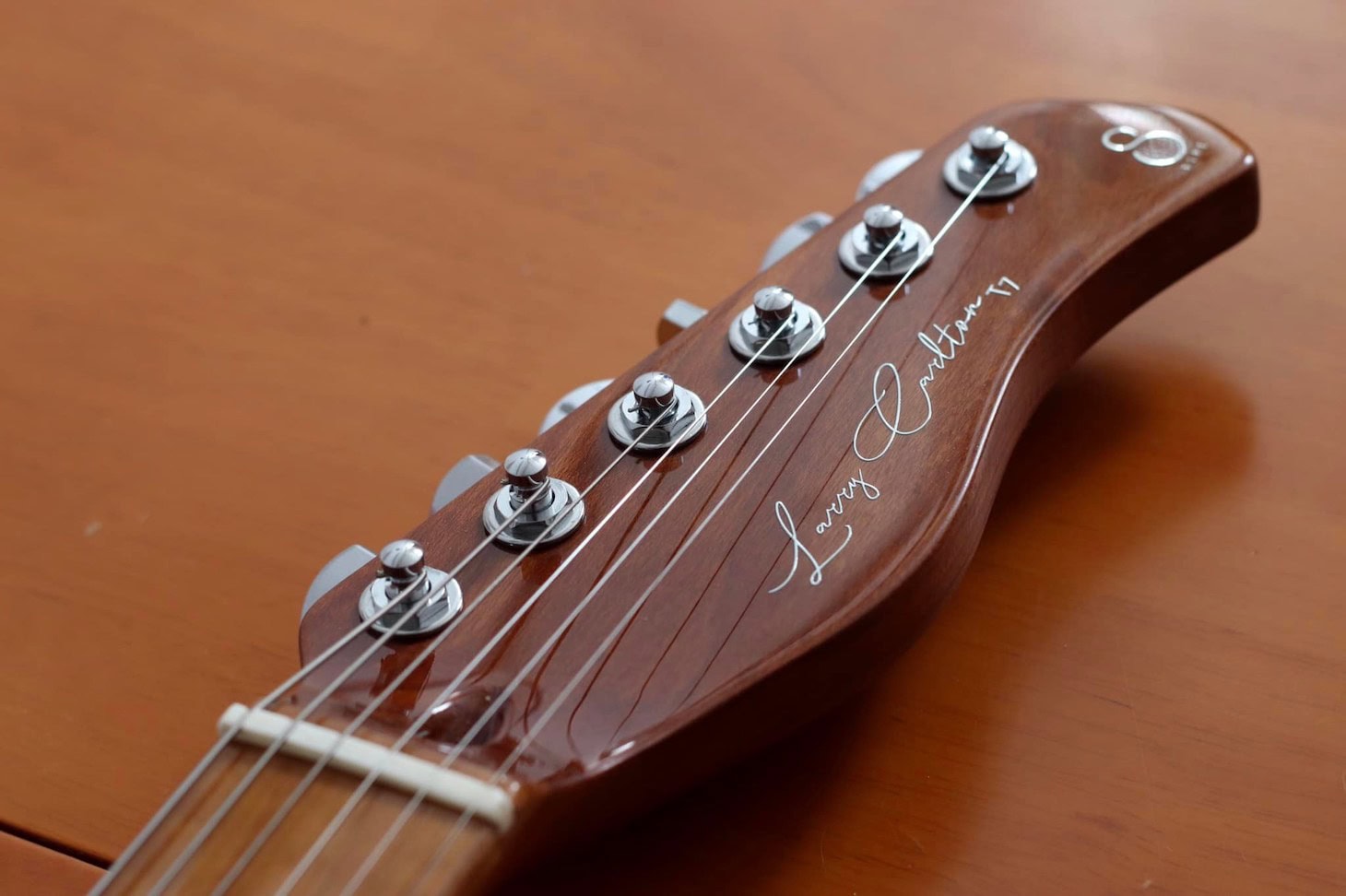
While the design stays true to the Telecaster formula, using the same single-coil and lipstick pickup configuration combined with the flat control plate, the headstock has been adjusted slightly and looks far sleeker than the regular Fender headstock. There's also the T7 FM variant which comes with dual humbuckers.

Sire Larry Carlton T7 FM
I really like the darker roasted hard maple neck, not only is it going to be supremely stable as the roasting process removes all of the moisture and oils from the wood, the darker caramel color gives it a luxurious and rich appearance. The in-hand feel of the neck is incredible, and gives off the vibe of a much more expensive guitar when you first hold it.
Making things even better are the abalone dot inlays which blend into the fingerboard making them understated from a distance, but still functional when you’re up close.
Sire put a lot of attention to the smallest of details, such as the tone knobs, pickup switch, tuners (they're locking). Honestly, if anyone didn't tell me the cost beforehand, I'd probably keep this ahead of even the Fender American Standard Tele in terms of build quality and overall fit and finish.
Both the bridge and neck pickups are Sire’s own LC Super-T Single-coils, which have no problems nailing the signature Telecaster twang. But I found they still grit up nicely without introducing those nasty overtones like some of the very old Tele-pickups would. These are more functional for the modern musician, without giving up the core spirit of the Telecaster sound.
For the T7 FM variant, you get Sire LC Super-M humbuckers (high-output) instead.
The T7 is available in a number of colors (the Tobacco Burst is my favorite) and is a little bit cheaper than the Fender Player series, making it an excellent value proposition. For any non-brand-purist looking for a modern take on the Tele without taking away from its original spirit, the Sire T7 would be a no brainer!
4. PRS SE NF 53
Like everything else in their guitar line, when Paul Reed Smith decided to release his first Telecaster, he did it with a bombastic, game-changing instrument ready to repeat the success they had with Mayer’s Silver Sky (Your body’s from another brand!) Stratocaster copy.
While the PRS SE NF 53 certainly does hit all the main beats you’d expect from a T-style guitar, it’s got a few of its own unique quirks that seem to surprise everyone who tries it.
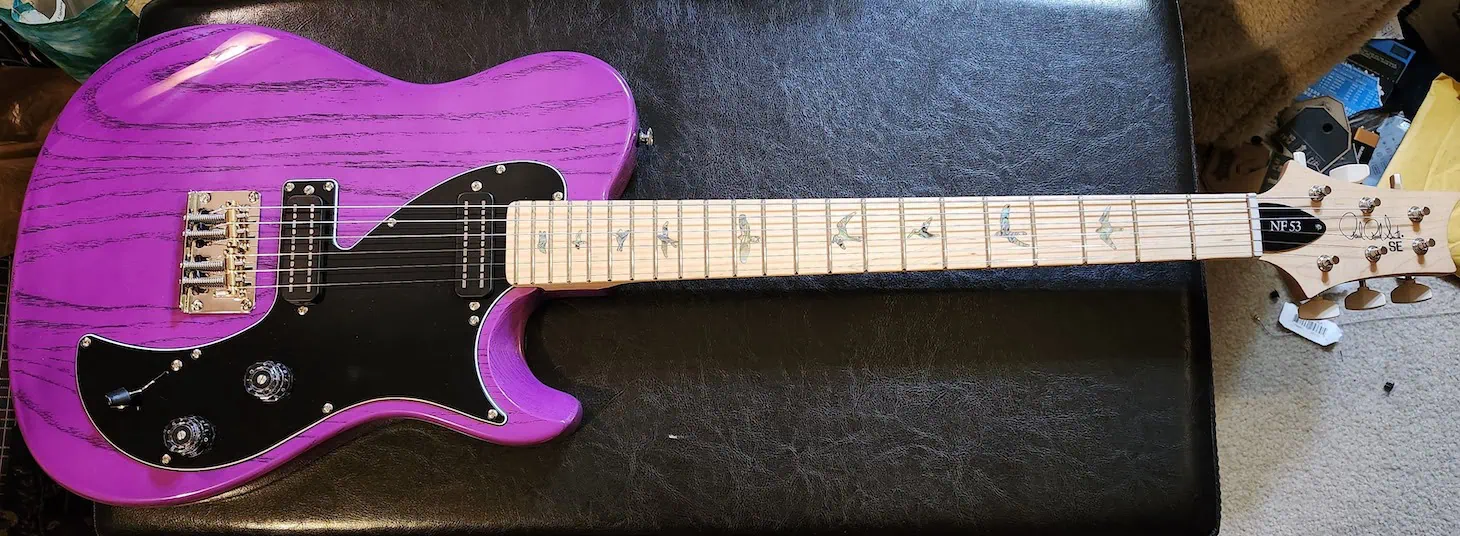
PRS SE NF53. The color is called 'Purple Doghair' (available on Sweetwater exclusively).
Primarily the body wood, which is swamp ash with a heavy grain (uncommon in this price point, I know), is a premium tonewood that provides a huge bump in the high midrange. It’s razor-sharp and ready to cut through anything.
Essentially, enhancing the honky twang you’d expect from a traditional Tele. A note apart about the purple color, Prince called from the other side and said it was just great.
This body wood is then combined with a hard maple neck which is both supremely stable and very comfortable. I mean, I know every guitarist has a neck preference. Well, for those who love that thick, round shape that sits in the palm of your hand, this neck is meaty and perfect. Also, its velvety, satin finish feels effortless and, to be honest, had me playing for hours. Plus, it adds that edge we love and the 22 medium jumbo frets are a great match for the 10” radius.
Yeah, this is a shredder, a fingerpicking, and a chord guitar all in one.
Speaking of which, the pickups are the revolutionary DD Narrow Fields. Yes, these are humbuckers but are tuned to be less punchy and glassier than you’d expect. I mean, don’t get me wrong, they sound wonderfully rich and are very quiet and easy to keep under control, a welcome reprieve for anyone who’s dealt with buzzy and noisy true single-coil Tele pickups before. Especially in this price range.
The bridge pickup, especially, offered amazing cleans. I played “Hotel California” and “Message in a Bottle” and it sounded glassy and pristine but with the round quality of a humbucker. The warmth and richness of the tone (through both the pickups) didn't take anything away from the top end, which isn't something you see much on anything other than higher-end guitars.
Perhaps, what I would have liked in this department is a five-way switch with coil tapping. I did miss the single-coil sound to push certain Rolling Stones riffs toward rock and roll territory. It lacks dirt; it’s a washed-up version. The middle position was the most tele-like of them all while the neck position gave me creamy sustain and Gary Moore-friendly soaring tones.
Sustain could improve if it was a string-through-body design like a classic Tele. That’s my second and last complaint about this outstanding instrument.
I also found the rounded over bridge rim really comfortable on my hands, so if like me you’ve always had a problem with the comfort of the regular Tele ‘ashtray’ bridge plates, you’ll no doubt find these far nicer on the hands! Oh, and the brass saddles also help warm up the tone.
If you want a very powerful Tele with a great midrange and shredding capabilities, give this guitar a try.
5. Charvel Pro-Mod So-Cal Style 2 24 2PT HH
The Telecaster has always had an association with vintage looks and tone, but over time there’s been a steady accumulation of guitars that aimed to modernize the design and essentially turn them into T-shaped super Strats.
Nothing encapsulates that concept better than the Charvel Pro-Mod So-Cal.
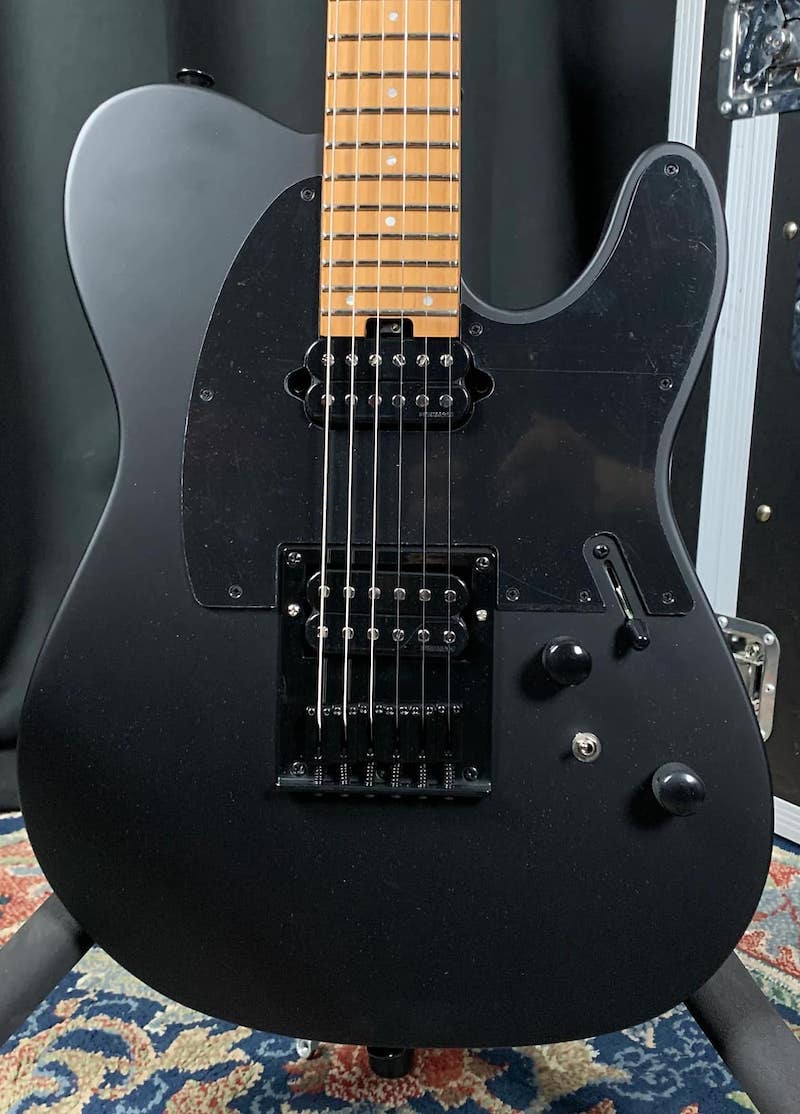
Charvel Pro-Mod So-Cal Style 2 24
It’s got everything you’d expect from an ultra-modern guitar: dual humbucking pickups, a floating bridge style with adjustable saddles, a 3-way blade switch, and angled controls to fit the curvature of your arm swing.
This makes it an ideal choice for anyone who likes the appearance of a Telecaster but needs a cutting-edge modern instrument that can handle rock and metal tones.
In other words, this is more catered towards the Jim Root and John 5 (Mötley Crüe) fans than Bruce Springsteen or George Harrison (remember his Tele playing in Abbey Road, Let It Be etc?) admirers.
The guitar takes on an all-black aesthetic with an open-pore matte black finish on its bright-sounding swamp ash body, the black pickguard and all-black hardware make this thing look like a sleek rock machine. Could it shred? Potentially, but I personally prefer double-cutaway bodies for that.
It has a 12”-16” compound radius neck meaning you’ll get much lower action than on a traditional Telecaster which helps accommodate faster playing for shredding and solos. I just found a few of the fret ends to be somewhat sharp, so they could've definitely been finished with a bit more care on a guitar of its price range.
The guitar is overall pretty comfortable too, generally weighing just around 8 lbs (so not the lightest either, but definitely not heavy).
But the real star of the show here are the Fishman Fluence Open Core Classic pickups which have 2 distinct voices you can activate by hitting the mini toggle switch situated between the tone and volume controls.
Between these two modes and the 3-way pickup selector, you’ve got access to 6 unique sounds making this possibly the most tonally versatile Tele I’ve ever played.
Even after I abused it (quite literally) for quite some time at a stretch, it retained tuning perfectly, on several occasions. Small things like this help somewhat justify the $1K+ price tag of higher-end guitars, in my opinion.
If you’re not much of a traditionalist and just want the single-cut shape, this is definitely one to check out. This made-in-Mexico axe definitely keeps up with my more expensive all-American guitars.
6. ESP LTD TE-200
The ESP LTD TE-200 is a guitar that’s a little confused in its design philosophy. It seems to want to be a modernized Telecaster but has gone so far that it’s ended up adopting more of a full-on metal super Strat vibe that just happens to be single-cut.
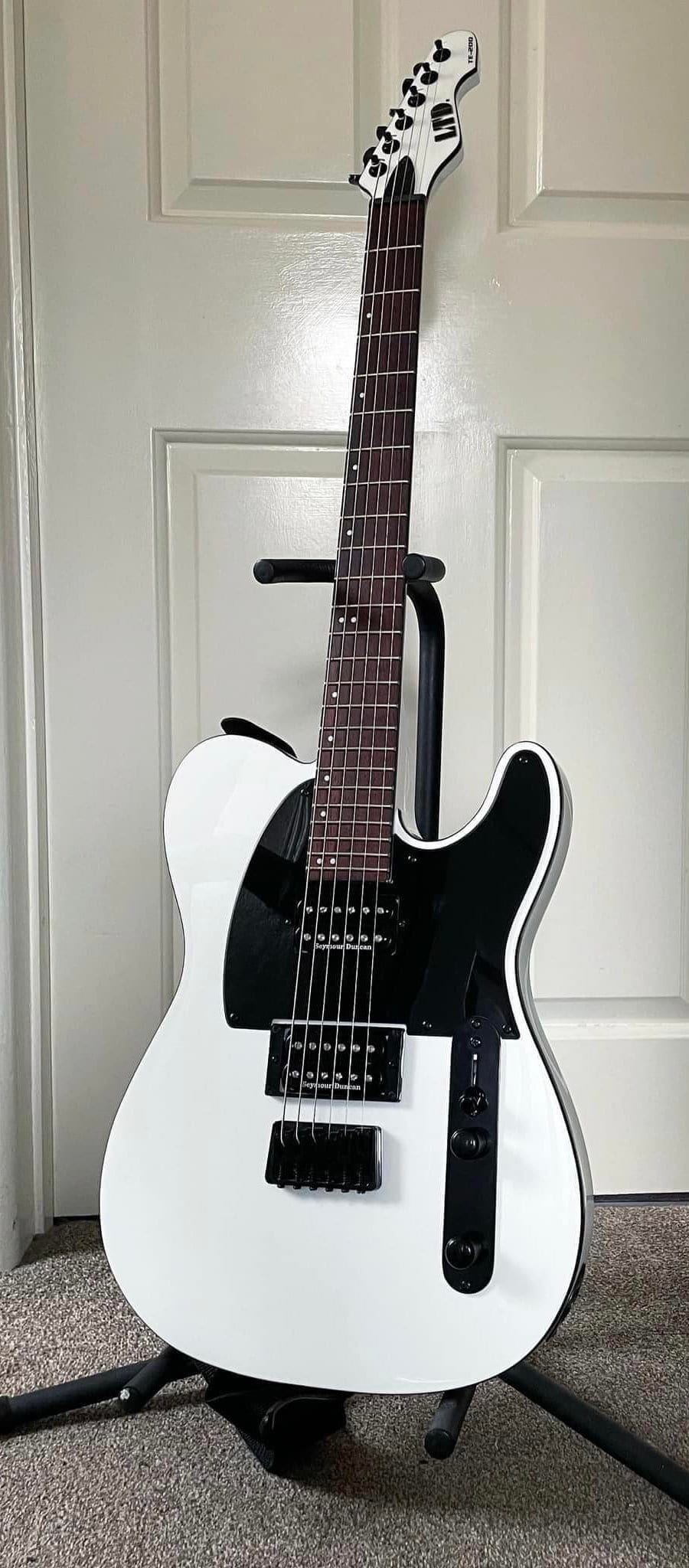
ESP LTD TE-200
Despite its unusual design ethos, there’s no denying its functionality and incredible price to performance. It certainly deserves a spot on this list!
The roasted jatoba fretboard atop the maple neck sits between a traditional rosewood fretboard and ebony, both in terms of appearance and in-hand feel.
On the more traditional side of things, you have a mahogany T-shaped body with a regular pickguard and traditional horizontal Telecaster control plate.
From there everything else sits firmly in the modern era with LTD’s fixed bridge, which is basically a hipshot bridge in all but name.
There are two of LTD’s own designed passive humbuckers which didn’t sound too great to me, but thanks to the pickup mounting rings you can easily replace them with aftermarket ones to improve the tone.
Although, one reason behind my disappointment could also be that this was likely the third guitar I was testing with the same setup (hooked up to my Fender Blues Jr), and I was playing the same stuff as I did on the earlier guitars (mostly songs that you associate a Tele with), which were closer in design (including tone) to the original Tele.
I tried playing some RATM, Keith Richards etc. later, but something about the tone kept bugging me. Most likely the mid-range.
One design aspect I found myself unexpectedly falling in love with was the inlays. There's something about the mini-dots that are tucked away at the top of the fretboard which makes the guitar look sleek and modern. I'm a huge fan of them and wish more guitars utilized this!
Overall this would be a guitar a modern metal player might enjoy, but traditionalists may be bothered by some of the design choices.
Check out our complete review of this guitar.
7. Godin Radium
The Godin Radium is going to be a great choice for anyone who’s looking to see the Telecaster formula shaken up and wants something that stands out.
Despite its overall leaning towards the Tele design, you’ll see a lot of Les Paul influence here with its paddle-style headstock and bar-bridge design.

Godin Radium, next to my Les Paul.
The Godin Radium has a solid basswood body (sourced locally in Canada like other Godin guitars) that has been left unfinished, although it’s also available in a painted Matte green finish if you’re not keen on the natural wood look. It's extremely lightweight at just under 7 lbs, and it was one of the reasons why I originally bought it.
The body shape is technically from a Godin Stadium model which is their take on the Tele. It’s been adjusted quite a bit from the regular T-shape body to have a more pronounced top ridge where your arm rests which felt super comfortable to play, but also the actual single cut is contoured which gives it its own unique look.
Pickup wise it has two of Godin’s own custom Zebra humbuckers in the bridge and neck position, both of which sounded modern and punchy. The middle pickup has a Cajun Nickel single-coil with a metal cover that matches the silver bridge and control plate.
While there’s only a 3-way toggle switch you do have a push/pull switch on the tone knob which coil splits the humbuckers to allow you to achieve a huge range of tones.
The middle pickup offers the classic bright and twangy tone that Telecasters are known for. So unlike a few other T-style guitars I talked about in this article, the Godin retains the Tele essence quite well.
Since I've owned this for quite some time now, it's always been a head-turner and prompted countless questions during gigs and even at a couple of recording sessions. The finish and in-hand feel is truly unique and although you can either love or hate it, the scale seems to be generally tipped in favor of the former.
If you like the idea of playing both a Les Paul and a Telecaster at the same time, this is going to be perfect for you.
How Much Should I Spend on a Telecaster?
One of the biggest questions buyers have when picking out their next guitar purchase is how much they should spend.
Some top-end Telecaster-style guitars can cost thousands of dollars, while there are other mass-produced ones that only cost a few hundred, it’s easy to fall into the trap of thinking that just because a guitar is cheaper it must be no good.
To fully understand where the value lies in guitars you have to understand the price to performance curve and how strongly diminishing returns sets in once you go above the $1,000 mark.
While ultimately value is relative and subjective, I have some general guidelines I can offer which can help organize guitar price points to help you better understand when you’re paying for an objective performance increase, and where the price is factoring in brand name and heritage.
Generally speaking guitars in the $150-$500 range are considered beginner guitars. These will often be produced using cheaper materials en masse to keep prices as low as possible.
But it’s important to note that guitar manufacturing and QA checks these days are pretty darn good, and these cheaper guitars will still play perfectly fine. More advanced players who want the most comfortable neck, nicer sounding pickups, and better construction for tuning stability might want to consider a more expensive guitar.
Anywhere from $600-$1,200 is really where you’re getting the most bang for your buck. They’ll be better built, use nicer woods and hardware and will just generally sound and feel better to play. They’ll be perfectly adequate for any professional musician.
Once you head above $1,200 you start to get into premium instrument territory. This is where you will see substantial diminishing returns in the price to performance. A $3,000 guitar isn’t going to feel or play that much better than a $1,200 guitar.
So why do people buy premium guitars?
Simply put, it’s because they love guitars. Having a premium guitar with a special finish, fancy woods, and is handmade by a well-respected luthier can be worth a lot to someone who is passionate about the instrument.
Ultimately there is no right or wrong price point for guitars, they are there to accommodate the needs of different buying markets. So by identifying what your needs are, you can ensure you’re only spending what you need to without being lured into paying extra for an instrument that’s not providing any tangible benefit.
What Makes the Telecaster So Good?
The Telecaster was designed to be a simple, no-frills budget guitar that was affordable while still sounding and playing good enough to be used by any working professional musician.
It’s this simplicity that has kept the T-style guitar popular for so long.
Telecaster offered a far easier playing experience with a far simpler 3-way toggle and single volume/tone knob setup when compared to the Stratocaster's 5-way toggle switches or a Les Pauls's complicated control setup.
There’s always been a demographic of guitarists who value this no-nonsense approach to guitar.
While over the years companies have flirted and experimented with this formula to include strange and unusual configurations and designs, ultimately it’s this traditional Telecaster philosophy of simplicity that keeps bringing people back.
Are Tele-style Guitars as Good as Real Fenders?
Branding and FOMO are big players in the guitar space. So with the original Telecaster being designed and manufactured by Fender, there’s a very natural pull for buyers to want to buy an official Fender Telecaster.
But Fender shouldn’t be put up on a pedestal here, all the big guitar companies such as Fender and Gibson have their fair share of problems and many smaller companies make fantastic instruments that can certainly punch at the same weight as these huge companies.
Fender Telecasters are truly great instruments, but I highly recommend considering T-style guitars from other companies as there are plenty out there that are as good as, if not better than traditional Fender Telecasters.
The Timeless T-guitar
As wonderful as it is that the guitar industry tries to innovate and try new things, there’s no denying that the Telecaster is one of the greatest guitar designs of all time and is certainly not going anywhere any time soon.
Having a nice sounding and feeling Tele is going to be a huge asset to anyone's guitar collection, and I hope you find the information shared today helpful on the journey to finding yours!

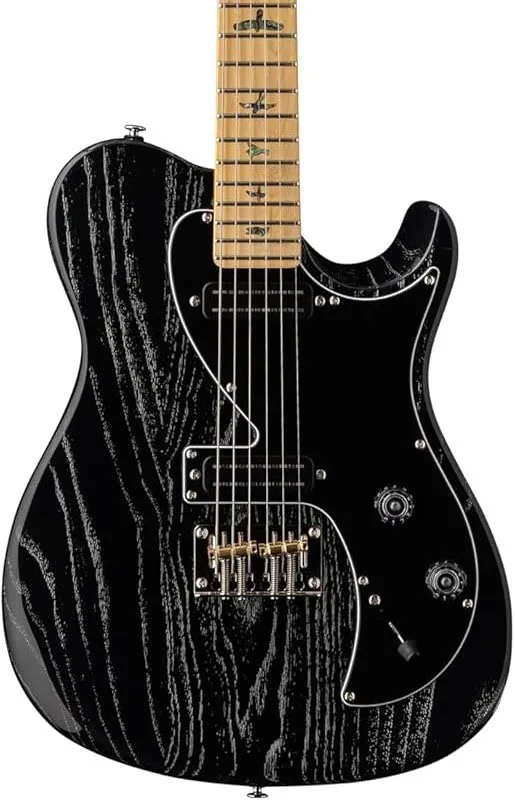


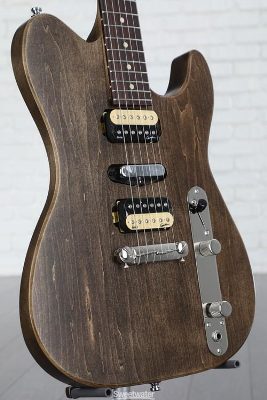
Wow. $1000 alternatives. So helpful
Most are under $1K. The ESP LTD TE-200 is $399, and there’s a cheaper version from Sire called the T3 which retails for the same price. But if you’re looking for even cheaper options from name-brands, there’s really not many options other than Squier (I actually like the Debut series Tele for the price).
I have one of the older lefty LTD T-200’s. I bought it as just a kick around travel guitar but I’m impressed as well. Yes I’m a metalhead. After taking the entire thing apart and rebuilding it (there were a few minor flaws like a bad tone pot and a couple of stripped screws) and replacing the pickups with a pair of Seymour Duncan Sentient / Pegasus combo holy hell did she sounds good. Mine has the mahogany body with maple fretboard.